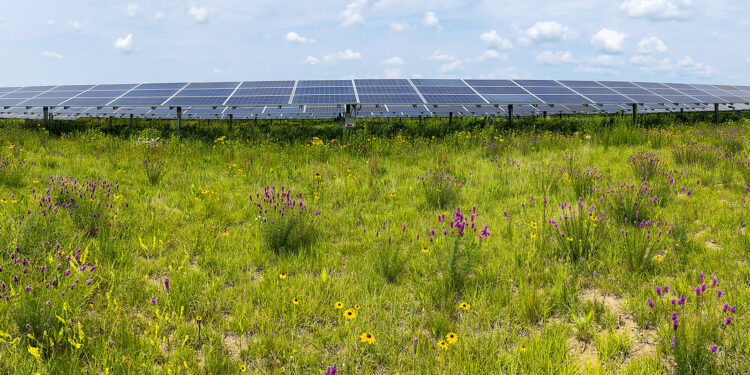A sun pollinator habitat, dominated by prairie purple clover and black-eyed susan flowering plants. Credit: Argonne National Laboratory/Lee Walston
Bumblebees buzz from flower to flower, pausing for a moment under a clear blue Minnesota sky. The birds are chirping and the tall grass is blowing in the breeze. This is not a scene from a pristine nature reserve or national park. It is nestled between photovoltaic (PV) solar panels on rehabilitated agricultural land.
Researchers at Argonne National Laboratory and the U.S. Department of Energy’s (DOE) National Renewable Energy Laboratory wanted to understand the ecological value of solar photovoltaic power sites planted with native grasses and wildflowers. They examined how vegetation would become established and how insect communities would respond to the newly established habitat. The five-year field study published in Environmental Research Letters looked at two solar sites in southern Minnesota operated by Enel Green Power North America. Both sites were built on abandoned agricultural land.
Smart land use choices deliver multiple benefits
Global insect biodiversity is declining due to habitat loss, pesticides and climate change. Restoring insect habitat, combined with smart changes in land use towards renewable energy development, could help reverse the trend.
For example, as a carbon-neutral source of electricity, increased development of solar photovoltaics is essential to mitigating climate change. According to the DOE’s Solar Future Study, approximately 10 million acres of land in the United States will be needed for large-scale solar development by 2050 to meet grid decarbonization and climate change goals. . But some lands are better suited than others to the development of photovoltaic solar energy. Disturbed land such as old agricultural fields are ideal places to install rows of solar panels compared to land that had not been previously disturbed.
Even more strategies can be added to this winning combination to support insect conservation. Agrivoltaics is the combination of solar energy production with agricultural and vegetation management practices. One type of agrivoltaics focuses on creating habitats for pollinating insects and other wildlife that can provide important ecosystem services, such as pollination.
Pairing solar energy installations on previously disturbed land with habitat improvement appears to be a logical win-win strategy for addressing energy and biodiversity challenges. However, to date, little field data is available to document the feasibility and ecological benefits of this new land use approach.
An Argonne scientist studies pollinators in a large-scale solar installation. Credit: Argonne National Laboratory/Lee Walston
If you build it, will they come?
The two solar sites studied were planted with native grasses and flowering plants in early 2018. From August 2018 to August 2022, researchers conducted 358 observational surveys of flowering vegetation and insect communities. They assessed changes in the abundance and diversity of plants and insects during each visit.
“The effort to obtain this data was extensive, returning to each site four times per summer to record pollinator numbers,” said Heidi Hartmann, land resources and energy policy program manager in the University’s Science Division. environment of Argonne and one of the co-leaders of the study. authors. “Over time, we saw the numbers and types of flowering plants increase as the habitat matured. Measuring the corresponding positive impact for pollinators was very rewarding.”
By the end of the field campaign, the team had observed increases in all habitat and biodiversity parameters. There has been an increase in native plant species diversity and flower abundance. In addition, the team observed an increase in the abundance and diversity of native pollinating insects and insects beneficial to agriculture, including honeybees, native bees, wasps, hornets, hoverflies, d Other flies, moths, butterflies and beetles.
Flowers and flowering plant species have also increased. The total abundance of insects tripled, while the number of native bees increased 20-fold. The most numerous insect groups observed were beetles, flies and moths.
As an added benefit, researchers found that pollinators from solar sites also visited soybean flowers in adjacent crop fields, providing additional pollination services.
A monarch caterpillar on a common milkweed leaf. Credit: Argonne National Laboratory/Lee Walston
The Benefits of Solar Pollinator Habitats
“This research highlights the relatively rapid responses of insect communities to habitat restoration at solar power sites,” said Argonne landscape ecologist and environmental scientist Lee Walston, lead author of the study. ‘study. “This demonstrates that, if properly sited, habitat-friendly solar energy can be a feasible way to safeguard insect populations and improve pollination services in adjacent agricultural fields.” Walston also serves as chief of the Department of Ecology, Natural Resources and Managed Systems in Argonne’s Environmental Sciences Division.
The research findings suggest two important implications of habitat-friendly solar energy. The first is that habitat-friendly solar sites can play an important role in biodiversity conservation. Large amounts of ground-mounted solar power are expected to be developed in the future, but if properly sited, habitat-friendly solar installations can offset losses of natural areas and provide benefits to biodiversity.
Second, habitat-friendly solar sites can help alleviate land use conflicts associated with the conversion of agricultural land for solar energy production. Given that approximately 80% of future ground-mounted solar developments could take place on agricultural land, properly siting habitat-friendly solar on marginal agricultural land can not only preserve prime agricultural land , but could also make prime agricultural land more productive through pollination services provided by habitat-friendly solar power.
Overall, more research is needed to understand the feasibility of habitat-friendly solar energy in different regions and to achieve different ecological goals such as conservation of a target insect or wildlife species.
More information:
Leroy J Walston et al, If you build it, will they come? Responses of insect communities to habitat establishment at solar energy installations in Minnesota, USA, Environmental Research Letters (2023). DOI: 10.1088/1748-9326/ad0f72
Provided by Argonne National Laboratory
Quote: Insect populations thrive in restored habitats of solar energy installations (January 17, 2024) retrieved January 18, 2024 from
This document is subject to copyright. Except for fair use for private study or research purposes, no part may be reproduced without written permission. The content is provided for information only.



